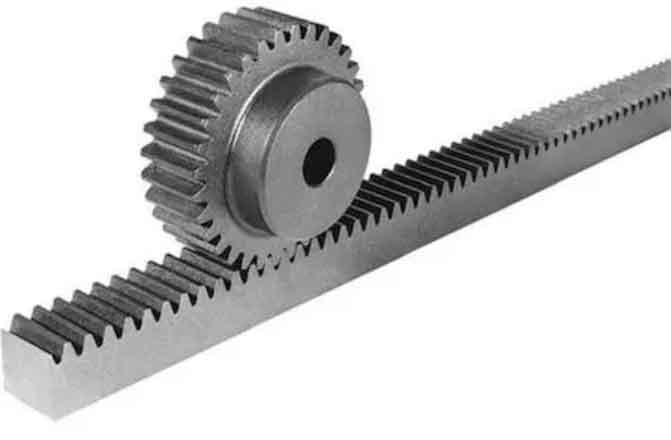
Rack and pinion gears are mechanical components that convert rotational motion into linear motion or vice versa. They consist of a flat or cylindrical gear called the rack and a small gear called the pinion. Here’s a closer look at the mechanics and applications of rack and pinion gears:
Mechanics of Rack and Pinion Gears:
In a rack and pinion system, the pinion gear meshes with the teeth on the rack, creating a rolling contact between the gears. As the pinion rotates, it causes the rack to move linearly. This motion conversion is achieved due to the teeth on the pinion engaging with the teeth on the rack, causing the linear displacement.
The key mechanical features of rack and pinion gears are:
- Tooth Profile: The teeth on both the rack and pinion gears are designed with a specific profile, typically involute, to ensure smooth meshing and efficient power transmission.
- Module and Pitch: The module refers to the size of the gear teeth, while the pitch represents the distance between corresponding points on adjacent teeth. These parameters determine the gear’s dimensions and tooth spacing.
- Contact Ratio: The contact ratio is the number of pairs of teeth in contact at any given moment. Higher contact ratios result in smoother operation and reduced wear.
- Backlash: Backlash is the amount of free movement between the teeth when the gears change direction. Minimizing backlash is crucial for precision and accuracy in applications.
Applications of Rack and Pinion Gears:
Rack and pinion gears find a wide range of applications across various industries due to their mechanical advantages, including:
- Automotive Steering: Rack and pinion gears are extensively used in automotive steering systems to convert the rotational motion of the steering wheel into linear motion for turning the wheels. The precise motion control and compact design of rack and pinion systems make them ideal for this application.
- CNC Machines: Rack and pinion gears are commonly employed in computer numerical control (CNC) machines, such as routers and plasma cutters. They provide accurate positioning and rapid movement along the axes, enabling precise cutting and shaping of materials.
- Industrial Machinery: Rack and pinion gears are used in various industrial machinery applications, such as material handling systems, packaging machines, and linear actuators. They provide reliable and efficient linear motion control in these systems.
- Robotics: Rack and pinion gears play a crucial role in robotics for precise linear motion control. They are used in robotic arms, gantry systems, and other robotic applications that require accurate positioning and smooth motion.
- Elevators: Rack and pinion gears are utilized in elevator systems to convert the rotational motion of the motor into vertical linear motion. They ensure safe and efficient vertical transportation in buildings.
- Camera Sliders: Rack and pinion gears are employed in camera sliders, enabling smooth and precise linear motion for camera movements during video or cinematography.
- Printing Presses: Rack and pinion gears are utilized in printing presses for precise paper feeding and accurate registration of colors during the printing process.
These are just a few examples of the numerous applications of rack and pinion gears. Their versatility, compact design, precise motion control, and efficient power transmission make them indispensable in various industries and mechanical systems.
